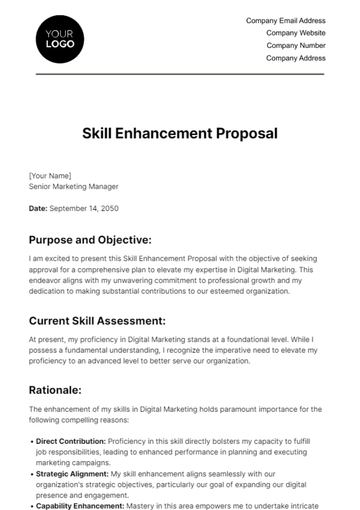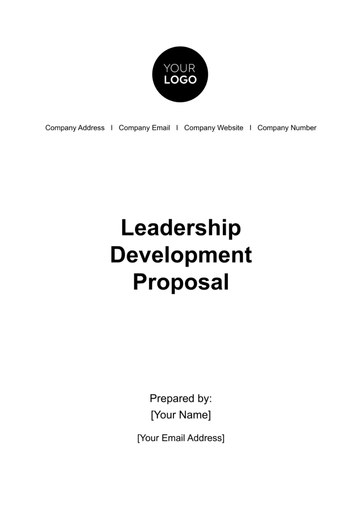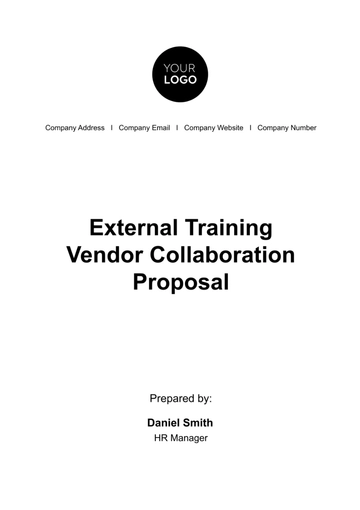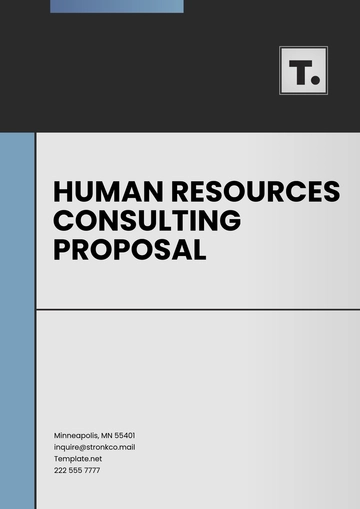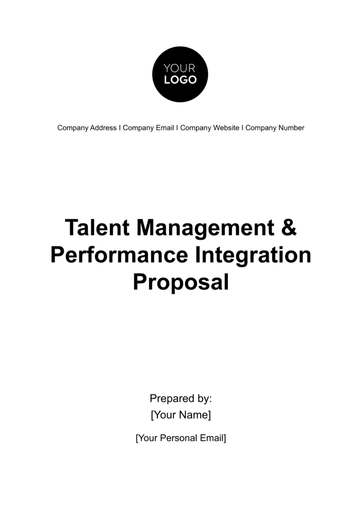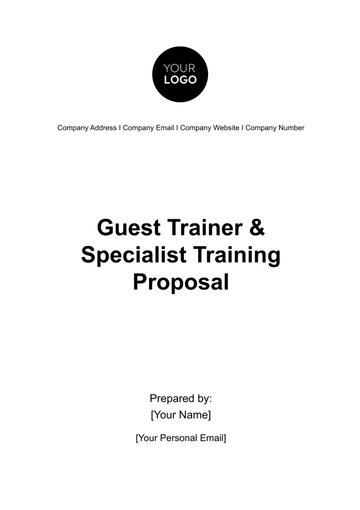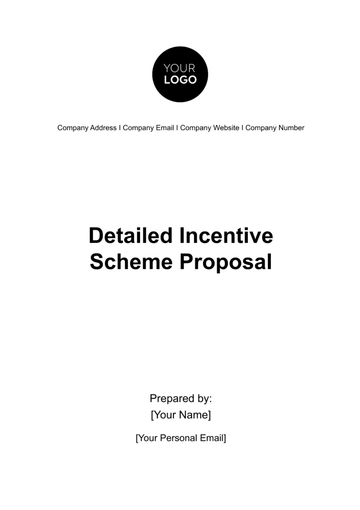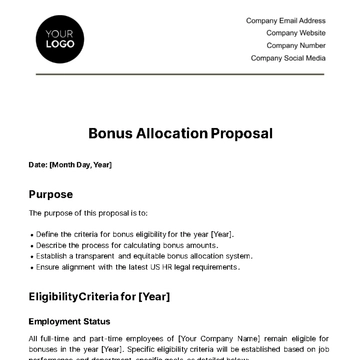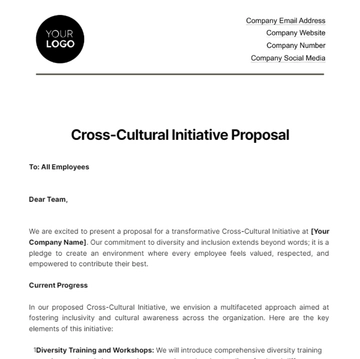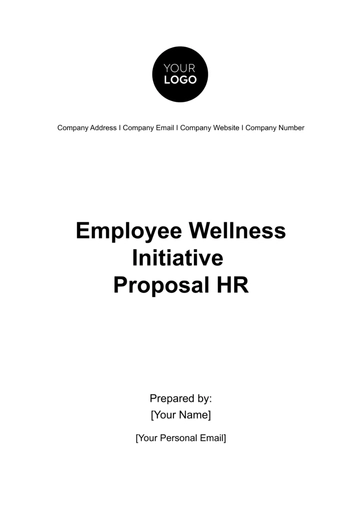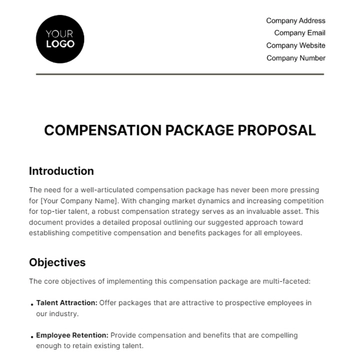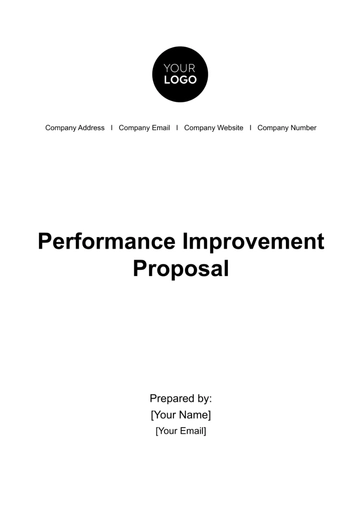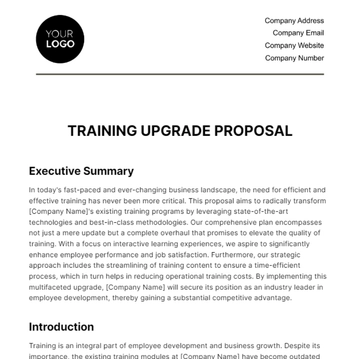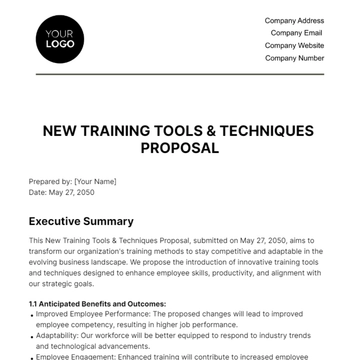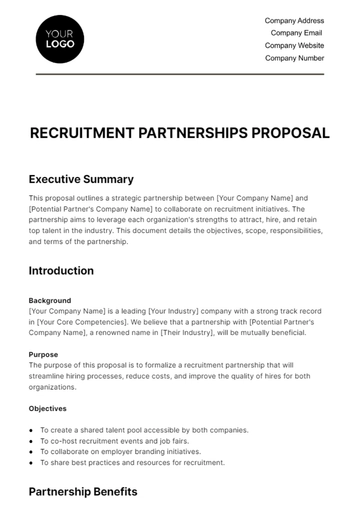Free Leadership Development Proposal HR
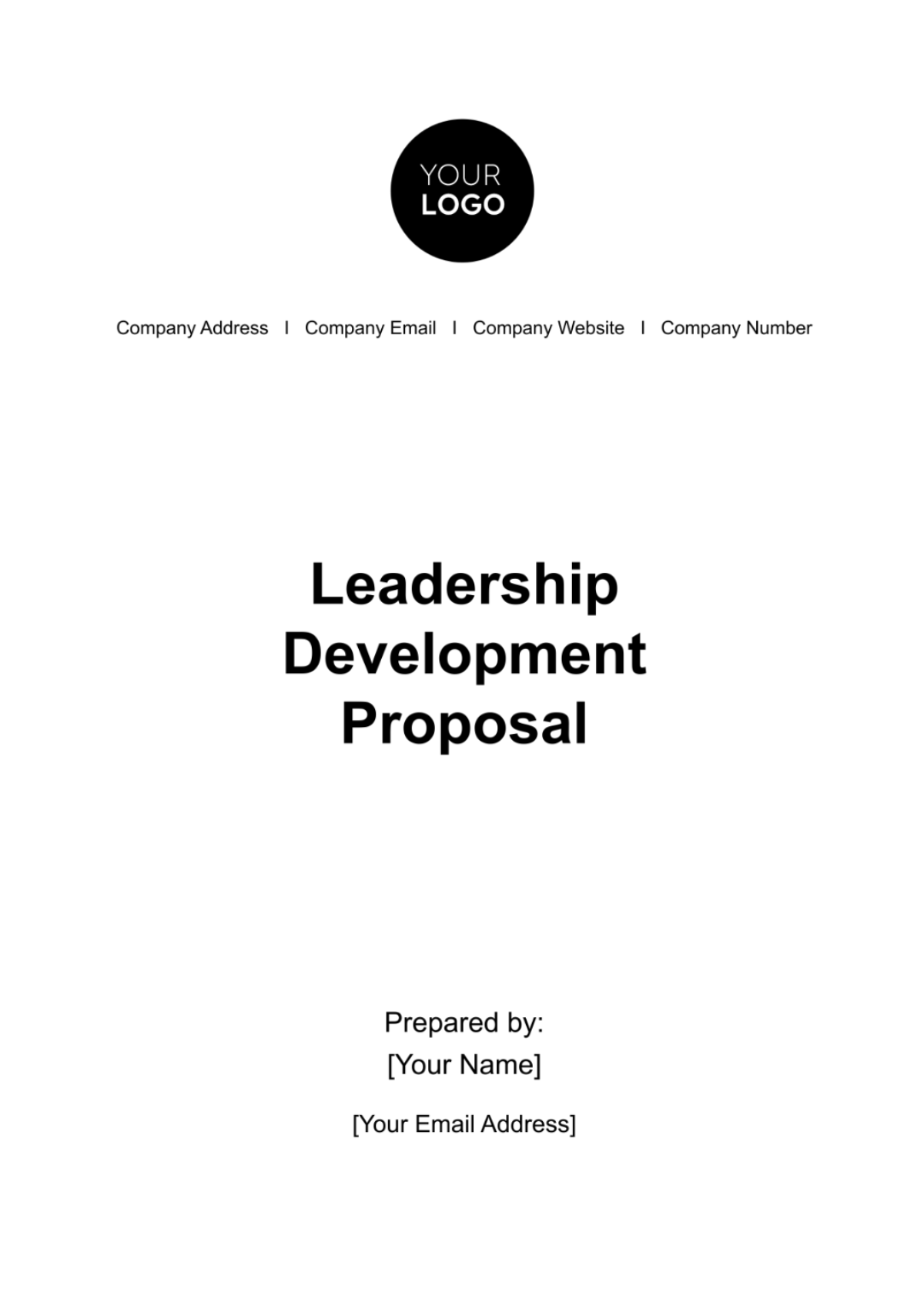
Table of Contents
1. Executive Summary .....................................................................................2
2. Introduction ..................................................................................................2
3. Objectives .....................................................................................................3
4. Needs Analysis ............................................................................................3
5. Target Audience ..........................................................................................4
6. Program Outline ...........................................................................................5
7. Methodology .................................................................................................5
8. Duration and Timeline ................................................................................6
9. Budget and Pricing ......................................................................................7
10. Evaluation and Metrics ............................................................................7
11. Conclusion ...................................................................................................8
12. Appendices .................................................................................................8
1. Executive Summary
The constantly evolving business landscape demands agile, competent leaders who can adapt to changes and steer organizations towards success. Recognizing this need, this proposal aims to introduce a holistic Leadership Development Program specifically tailored for [Company Name]. Our program is designed not only to enhance the skill set of current leaders but also to cultivate a pipeline of future leaders within the organization. The comprehensive plan combines a variety of effective training approaches to offer a balanced and well-rounded leadership development experience.
The program consists of three key pillars: experiential learning, skill-building workshops, and one-on-one coaching sessions. Experiential learning will provide real-world scenarios and case studies to enhance problem-solving and decision-making skills. Skill-building workshops will focus on key competencies like communication, strategic thinking, and emotional intelligence. Meanwhile, one-on-one coaching sessions will offer personalized guidance and support, allowing individuals to address specific challenges or growth areas.
By implementing this Leadership Development Program, [Company Name] is making a strategic investment in its human capital. Developing leaders from within ensures a deep-rooted understanding of company culture, values, and long-term objectives, setting the stage for sustained organizational growth and success.
2. Introduction
Leadership is often cited as one of the most crucial factors in the success or failure of any organization. It is the cornerstone upon which cultures are built, strategies are executed, and businesses grow. In this fast-paced, ever-changing world, [Company Name] understands the pressing need for adaptive, skilled leaders who can navigate complex environments, manage diversity, and steer the organization towards its strategic goals. The urgency to develop these leaders has never been more critical.
To this end, this proposal has been developed to launch a structured, scalable, and sustainable Leadership Development Program at [Company Name]. This program is not just another training exercise but a strategic initiative tailored to meet the unique challenges and opportunities that our organization faces. The aim is to instill a culture of continuous improvement and learning, ensuring that the leaders of today and tomorrow are well-equipped to manage both the operational and strategic facets of our business.
This Leadership Development Program is meticulously designed to be modular yet integrated, comprising various components that range from experiential learning to mentorship, from skill-building workshops to hands-on project assignments. It aims to create a nurturing ecosystem where leaders can learn, grow, and most importantly, contribute effectively to [Company Name]'s vision and mission. With this initiative, we aspire to build a cadre of leaders who are not just managers but influencers, visionaries, and architects of sustainable success.
3. Objectives
In the quest for organizational excellence, it's critical to have clearly defined objectives that guide the implementation of any development program. The objectives serve as the compass that ensures all efforts align with the larger goals of the organization. For the Leadership Development Program at [Company Name], we have delineated the following key objectives to provide direction and purpose:
Develop Essential Leadership Skills, Including Strategic Thinking and Emotional Intelligence
The program aims to cultivate core leadership competencies such as the ability to think strategically and understand the emotional components of leadership. Participants will engage in workshops and activities that enhance their decision-making, problem-solving, and people-management skills.
Foster a Culture of Continuous Learning and Development
The success of an organization is intrinsically linked to its commitment to ongoing learning and development. Through this program, we aim to ingrain a learning culture where continuous improvement is not just encouraged but celebrated. This includes offering regular training modules and creating platforms for knowledge sharing.
Retain Top Talent by Providing Career Advancement Opportunities
Employee retention is a growing concern in today's competitive landscape. By investing in leadership development, [Company Name] aims to provide a clear pathway for career progression. This not only helps to keep high-performing individuals within the company but also sends a strong message about our commitment to employee growth and development.
4. Needs Analysis
Before diving into the development and implementation of a Leadership Development Program, it is crucial to first understand the gaps that exist within the current leadership framework. Identifying these gaps allows us to tailor the program in a way that addresses specific needs, ensuring maximum effectiveness and impact. The Needs Analysis phase serves as the diagnostic component of our program, where we assess various skills and attributes essential to leadership at [Company Name].
In this section, we present an initial analysis that identifies key skills and attributes, gauges the current level of proficiency, and outlines the desired level of mastery. We also quantify the gap between the current and desired states to establish a clear roadmap for improvement. For instance, our analysis indicates that while there is a high level of competency in communication, there is still a 15% gap that needs to be addressed to reach an 'Exceptional' level. Similarly, there exists a 25% gap in decision-making skills, elevating it from 'Moderate' to 'High' proficiency.
The data presented here lays the groundwork for the detailed, customized interventions that will form the core of the Leadership Development Program.
Skill/Attribute | Current Proficiency | Desired Proficiency | Gap |
Decision-making | Moderate | High | 25% |
Communication | High | Exceptional | 15% |
5. Target Audience
For a Leadership Development Program to be most effective, it's vital to identify the specific groups within the organization who would benefit the most from the training. By targeting the right audience, we ensure that our efforts and resources yield the maximum impact. This chapter outlines the various groups within [Company Name] who are considered the primary beneficiaries of the Leadership Development Program.
Current Team Leaders and Supervisors
These individuals already have some level of managerial responsibility and are usually the immediate point of contact for most employees. Enhancing their leadership skills will not only improve their own performance but also have a cascading effect on their teams. They are integral to disseminating the culture of continuous learning and improvement we aim to foster.
High-Potential Employees Identified for Leadership Roles
This group comprises talented employees who have been recognized for their potential to assume leadership roles in the future. Investing in their development now prepares them for these roles and aids in succession planning, ensuring that the organization has a steady stream of competent leaders for the future.
Senior Management
While they are already in leadership roles, continuous development is crucial for senior management to adapt to changing business landscapes and lead the organization effectively. The program will offer advanced modules catering to the complex and strategic challenges that senior leaders often face, keeping them at the forefront of leadership excellence.
6. Program Outline
The Leadership Development Program at [Company Name] is structured into a series of modules, each targeting different yet interrelated aspects of leadership. The modular approach allows for flexibility in delivery and ensures that each participant can derive maximum benefit tailored to their specific needs. Below is a detailed table outlining the key modules, their focus areas, and what participants can expect to gain from each.
Module | Focus Areas | Learning Outcomes |
Module 1: Emotional Intelligence | Identifying and Managing Emotions | Participants will learn techniques for identifying their own emotions and those of others. They will also acquire strategies for managing emotional reactions in various situations, thus enhancing interpersonal effectiveness. |
Module 2: Strategic Thinking | Business Strategy Development and Implementation | Participants will engage in hands-on activities that help them understand the nuances of business strategy. They will learn how to develop, implement, and monitor a strategic plan, equipping them with the skills needed for effective organizational leadership. |
This table serves as a blueprint of the Leadership Development Program, providing a snapshot of the content-rich, skill-building modules that participants will undergo.
7. Methodology
In the design and delivery of [Company Name]'s Leadership Development Program, we've adopted a multifaceted methodology to provide a well-rounded experience for our participants. This ensures not only the acquisition of new skills but also the practical application and internalization of these competencies. The methodology is rooted in three key approaches, each of which brings its own set of benefits and learning outcomes.
Experiential Learning
Going beyond traditional classroom lectures, experiential learning immerses participants in real-world scenarios where they can apply their skills. Whether it's through case studies, role-playing, or on-the-job tasks, this approach allows for immediate feedback and deep-rooted learning, making the experience highly engaging and impactful.
Skill-building Workshops
These workshops focus on imparting specific skills and techniques that are crucial for effective leadership. Conducted by industry experts, these sessions offer hands-on activities, discussions, and exercises aimed at enhancing competencies like strategic planning, problem-solving, and effective communication among others.
One-on-one Coaching
Personalized coaching sessions provide an opportunity for participants to delve deeper into their individual challenges and aspirations. These sessions are geared towards helping leaders understand their own leadership styles, identify areas for improvement, and develop action plans to achieve their professional goals.
By integrating these approaches, the Leadership Development Program aims to offer a robust and comprehensive learning journey for leaders at all levels within [Company Name].
8. Duration and Timeline
A well-defined timeline is crucial for the smooth implementation and success of the Leadership Development Program at [Company Name]. It not only helps in allocating resources efficiently but also ensures that all stakeholders are aligned and aware of key milestones. In this section, we provide a structured timeline that outlines the various phases of the program, along with their respective start and end dates.
Phase | Start Date | End Date |
Needs Assessment | [Date] | [Date] |
Program Rollout | [Date] | [Date] |
The "Needs Assessment" phase marks the beginning of our journey, where we will conduct a comprehensive analysis to identify the skill gaps within the target audience. Following the assessment, the "Program Rollout" phase commences, encapsulating the core modules and learning methodologies detailed earlier in this proposal.
This timeline serves as a roadmap to guide us through the various stages of the program, ensuring that we stay on track and achieve the program's objectives within the stipulated time frame.
9. Budget and Pricing
Financial planning and budget allocation are key aspects of the Leadership Development Program’s implementation at [Company Name]. A transparent and detailed budget is essential for ensuring the program's sustainability and effectiveness, and for securing stakeholder buy-in. In this chapter, we outline the financial considerations associated with various elements of the program.
Item | Cost |
Training Materials | $XXX |
Facilitators | $XXX |
The budget breakdown includes essential components like training materials, which encompass all educational resources, as well as the costs associated with hiring experienced facilitators to lead the skill-building workshops and coaching sessions.
Understanding the budgetary requirements upfront allows [Company Name] to allocate resources wisely and ensures that the program delivers maximum value for the investment made.
10. Evaluation and Metrics
A program's success can only be accurately gauged through meticulous evaluation against predefined metrics. For our Leadership Development Program at [Company Name], it is essential to track outcomes and measure them against Key Performance Indicators (KPIs). This chapter elaborates on the metrics we will employ to assess the effectiveness and ROI (Return on Investment) of the program.
We will focus on several KPIs, including but not limited to employee engagement scores, retention rates, and leadership effectiveness.
Employee Engagement Scores: Monitoring these scores before and after the program provides insight into how the training impacts employee morale and productivity. A marked increase would signify that the training has positively impacted the workforce.
Retention Rates: High retention rates are often indicative of a successful leadership program, as effective leadership is a key factor in employee satisfaction and, subsequently, retention. Tracking retention rates over a period of time post-implementation can help us assess the program's long-term impact.
Leadership Effectiveness: This can be measured through a variety of metrics, such as subordinate reviews, performance metrics, and project outcomes. The goal is to see a noticeable improvement in the quality of leadership, as evidenced by these indicators.
By regularly monitoring these KPIs and adjusting the program as needed, we aim to continuously improve the Leadership Development Program and ensure it meets its intended objectives, providing tangible benefits for [Company Name].
11. Conclusion
This Leadership Development Program represents a strategic investment in [Company Name]'s most valuable asset—its people. It aims to go beyond just skill enhancement by creating a culture of leadership and continuous learning that permeates every level of the organization. By incorporating a multifaceted approach that combines experiential learning, skill-building workshops, and one-on-one coaching, we have designed a program that is both comprehensive and tailored to meet the unique needs of our workforce. The program's success is underpinned by its adaptability and scalability, making it a sustainable initiative that can evolve with the organization's needs. Through meticulous planning, execution, and ongoing evaluation, we aim to elevate both individual and organizational performance. In doing so, we not only prepare our current and future leaders for the challenges that lie ahead but also set the stage for long-term success and growth for [Company Name].
12. Appendices
The following appendices are included to provide additional resources and detailed information that complements the main content of this Leadership Development Program proposal for [Company Name].
A. Sample Training Materials
Leadership 101 Handbook: A guide that offers an overview of basic leadership principles, from effective communication to decision-making.
Case Studies: Real-world scenarios where participants can apply their leadership skills and decision-making abilities.
Workshop Outlines: Detailed agendas for each skill-building workshop, including objectives, activities, and facilitator notes.
B. Detailed Budget Breakdown
Category | Item | Cost |
Training Materials | Printed Handouts | $200 |
Facilitators | Multimedia Content | $300 |
Interactive Tools | $100 | |
Workshop Leaders | $1,500 per session | |
One-on-one Coaches | $200 per hour | |
Venue & Logistics | Room Rental | $400 per day |
Refreshments | $100 per session | |
Miscellaneous Costs | Administrative Fees | $250 |
Marketing and Promotions | $300 |
This table provides a detailed breakdown of the budget allocation for the various components of the Leadership Development Program. It aims to offer a transparent overview of the costs involved, facilitating better financial planning and resource allocation for the program's successful implementation at [Company Name].
Submitted by: Joyce C. Crouch
HR Manager
joyceccrouch@mail.com
222 555 7777
15 January 2050
This Leadership Development Proposal is subject to approval and modification. For further inquiries or clarifications, please contact [Names] at [Company Email] or [Company Phone Number].
- 100% Customizable, free editor
- Access 1 Million+ Templates, photo’s & graphics
- Download or share as a template
- Click and replace photos, graphics, text, backgrounds
- Resize, crop, AI write & more
- Access advanced editor
Unlock the full potential of your team with our Leadership Development Proposal HR Template. This comprehensive guide offers a step-by-step roadmap to enhance leadership skills, foster a culture of continuous learning, and drive organizational success. Ideal for HR professionals, the template covers everything from objectives and budgeting to evaluation metrics. Take your HR strategy higher today!
You may also like
- Business Proposal
- Research Proposal
- Proposal Request
- Project Proposal
- Grant Proposal
- Photography Proposal
- Job Proposal
- Budget Proposal
- Marketing Proposal
- Branding Proposal
- Advertising Proposal
- Sales Proposal
- Startup Proposal
- Event Proposal
- Creative Proposal
- Restaurant Proposal
- Blank Proposal
- One Page Proposal
- Proposal Report
- IT Proposal
- Non Profit Proposal
- Training Proposal
- Construction Proposal
- School Proposal
- Cleaning Proposal
- Contract Proposal
- HR Proposal
- Travel Agency Proposal
- Small Business Proposal
- Investment Proposal
- Bid Proposal
- Retail Business Proposal
- Sponsorship Proposal
- Academic Proposal
- Partnership Proposal
- Work Proposal
- Agency Proposal
- University Proposal
- Accounting Proposal
- Real Estate Proposal
- Hotel Proposal
- Product Proposal
- Advertising Agency Proposal
- Development Proposal
- Loan Proposal
- Website Proposal
- Nursing Home Proposal
- Financial Proposal
- Salon Proposal
- Freelancer Proposal
- Funding Proposal
- Work from Home Proposal
- Company Proposal
- Consulting Proposal
- Educational Proposal
- Construction Bid Proposal
- Interior Design Proposal
- New Product Proposal
- Sports Proposal
- Corporate Proposal
- Food Proposal
- Property Proposal
- Maintenance Proposal
- Purchase Proposal
- Rental Proposal
- Recruitment Proposal
- Social Media Proposal
- Travel Proposal
- Trip Proposal
- Software Proposal
- Conference Proposal
- Graphic Design Proposal
- Law Firm Proposal
- Medical Proposal
- Music Proposal
- Pricing Proposal
- SEO Proposal
- Strategy Proposal
- Technical Proposal
- Coaching Proposal
- Ecommerce Proposal
- Fundraising Proposal
- Landscaping Proposal
- Charity Proposal
- Contractor Proposal
- Exhibition Proposal
- Art Proposal
- Mobile Proposal
- Equipment Proposal
- Student Proposal
- Engineering Proposal
- Business Proposal
